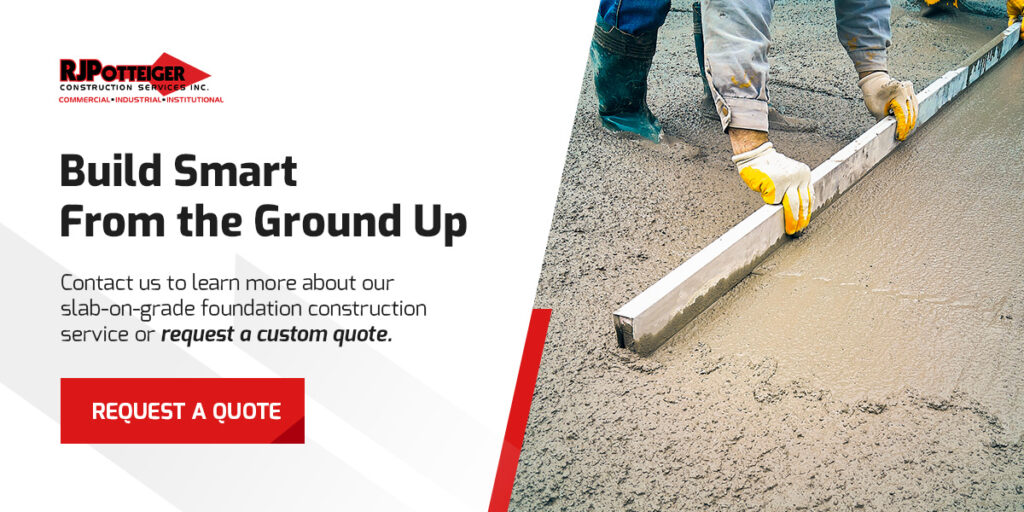What Is a Slab-on-Grade Foundation?
From warehouses to retail storefronts and single-story homes, slab-on-grade foundations are a common and practical choice in industrial, commercial and residential construction. Their simplicity, strength and speed of installation make them ideal when cost-efficiency and durability are top priorities.
Still, not all foundations are created equal, and understanding the meaning of slab-on-grade construction can help determine whether it’s the right fit for your next build.
The Specifics of Slab-on-Grade Construction
Slab on grade is a construction method that involves pouring a single, thick layer of concrete directly onto a prepared surface of compacted soil or gravel to form a building’s foundation. Unlike elevated foundations with basements or crawlspaces, this type of slab rests right on the ground (on grade). The slab’s perimeter is often deeper to support load-bearing walls, and the interior is reinforced with steel rebar or wire mesh to help control cracking.
Slab-on-grade foundations are widely used in properties such as garages, shopping centers and storage facilities. Their design eliminates the need for crawlspaces, making them simpler and more economical to construct, particularly on flat sites with stable soil conditions.
In many modern builds, the slab also serves as the finished floor surface, saving time and materials. When done right, it creates a strong, stable and low-maintenance foundation that performs well under heavy use.
How Slab-on-Grade Construction Works
One reason slab-on-grade foundations are so popular is their straightforward construction process. Here’s how it typically works from the ground up:
- Site prep: Construction workers first level the ground and compact the soil to create a stable base.
- Drainage layer: A layer of gravel or crushed stone is added to improve drainage and reduce moisture buildup beneath the slab.
- Moisture barrier: A plastic vapor barrier is placed over the gravel to protect the slab from ground moisture.
- Reinforcement: Next, steel rebar or wire mesh is installed to strengthen the slab and lower the risk of cracking.
- Concrete pour: Concrete is poured in one continuous operation and smoothed out. Edges may be deepened to support load-bearing walls.
- Curing and finishing: After the slab sets, it cures and may serve as the finished floor or receive additional treatments.
When Is a Slab on Grade the Right Choice?
While slab-on-grade foundations are versatile, they aren’t ideal for every project. They’re best suited to:
- Projects with tight timelines or budgets.
- Structures without basements (showrooms, warehouses, sheds).
- Flat sites with stable, well-drained soil conditions.
- Builds in warm or moderate climates.
- Facilities that require heavy load support or frequent equipment use.
- Buildings that need direct ground access.
Slabs on grade are often the most practical choice for commercial and industrial construction projects. Their structural strength and ability to handle heavy loads make them ideal for distribution centers, manufacturing plants and office buildings.
They’re also a smart option when speed and cost are important. With fewer excavation requirements, these foundations can reduce building costs and accelerate your construction timeline while delivering long-term performance.
Benefits of Slab-on-Grade Foundations
When properly designed and constructed, slabs on grade offer a durable, efficient base built for performance:
- Low maintenance: Fewer components mean less ongoing upkeep.
- Thermal performance: Concrete helps regulate indoor temperatures, lowering energy use.
- Pest resistance: The solid base leaves no hidden gaps for rodents or insects.
- Load-bearing strength: These slabs are ideal for heavy equipment and high traffic.
Potential Considerations and Limitations
Understanding the limitations of slab on grade can help ensure the right fit for your project. There are a few factors to keep in mind before construction begins:
- Cold climate performance: Without proper insulation, slabs may be vulnerable to frost heave in freezing temperatures.
- Limited access to utilities: Once poured, access to plumbing or electrical lines beneath the slab is challenging.
- Soil stability requirements: Sites with high water tables or unstable, expansive soils need proper prep and grading to prevent shifting or cracks.
- Permanent flooring finish: If the slab doubles as the floor, leveling and surface treatment must be precise from the outset.
These considerations aren’t deal breakers, but they do require experience. A skilled team like R.J. Potteiger Construction Services, Inc. will evaluate your site, address these challenges and deliver a foundation that performs reliably for years.
Slab-on-Grade Services From R.J. Potteiger Construction Services, Inc.
We bring over 30 years of hands-on experience delivering comprehensive concrete construction services for industrial, commercial and residential projects throughout Central Pennsylvania.
We tailor each project to meet structural and performance demands, and our skilled crews handle every phase from site prep and grading to installation.
Serving areas like Harrisburg, Carlisle, Mechanicsburg and surrounding regions, we focus on lasting results built for high traffic and demanding time frames. If you’re looking for a strong, reliable foundation built to spec, our team is ready to get to work.
Build Smart From the Ground Up
A slab-on-grade foundation can simplify your build without sacrificing strength or stability. Its straightforward construction and long-term performance make it a smart solution for many types of structures. At R.J. Potteiger Construction Services, Inc., we bring the skill, precision and attention to detail your project requires.
Contact us to learn more about our slab-on-grade foundation construction service or request a custom quote.




